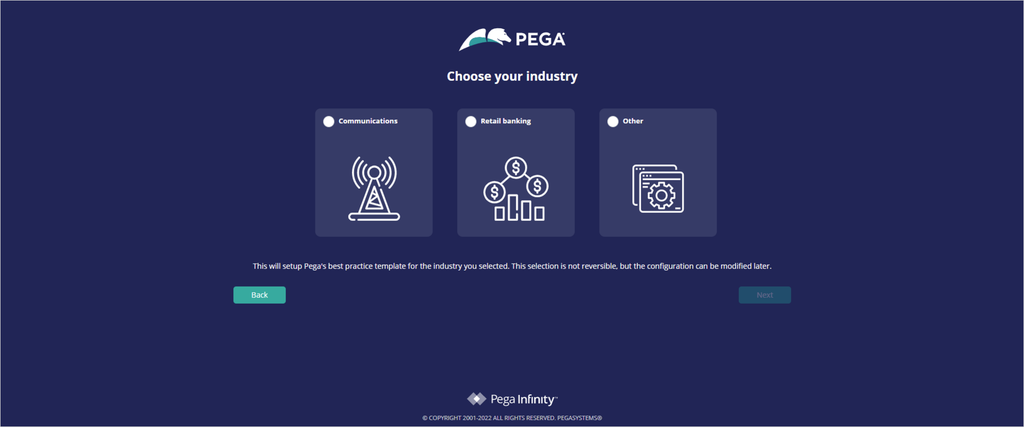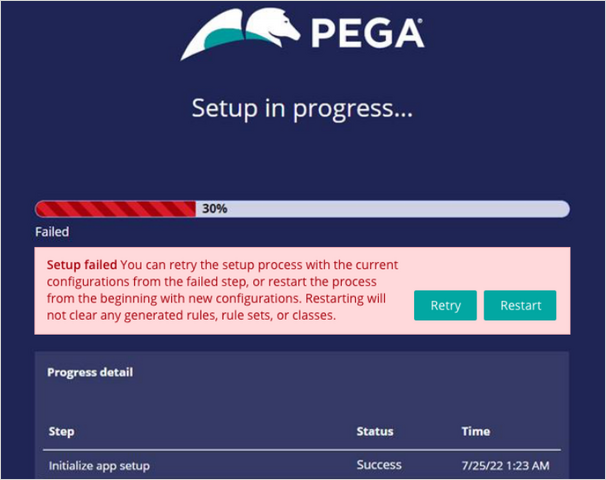
Pega Customer Decision Hub setup wizard
The Pega Customer Decision Hub™ setup wizard provides an automated, end-to-end process to complete the essential setup tasks of your Customer Decision Hub application. You can use the wizard to enable your team with efficiency to begin development immediately.
During the setup, you can pick from various industry templates that contain preconfigured best practices for data model and Next-Best-Action Designer configurations. Pega provides these configurations. They are the result of years of experience deploying Customer Decision Hub in various industries. It is recommended that your delivery team plan which templates will be used in your project ahead of time.
You can also select Other, and then upload your own data model and Next-Best-Action Designer template. You can use components from the Pega Marketplace or use your own templates. It is also possible to skip these configuration steps. In this case, you manually define the data model, and then configure the context dictionary. To save time and effort, define the data model and Next-Best-Action Designer configuration through the wizard. To create multiple applications, you run the setup wizard multiple times.
Run this application setup only in the development environment.
To allow change management and support different release cycles between technical (structural changes) and marketing operations (content changes) in the later stages of the project lifecycle, the wizard configures the Pega 1:1 Operations Manager extension application and the supporting overlay applications during the setup process. When the project is at the stage of maturity to engage change management, all environments are synced, and the business content team can start introducing new content in the business operations environment (BOE) by using 1:1 Operations Manager. The Deployment Manager migrates applications to higher environments through the deployment pipelines. The product rules required by the deployment pipelines are automatically created for you by the wizard.
You can select a file repository where the system automatically exports customer interactions and (optionally) decisions to support reporting and audit requirements, without creating custom flows. If you deploy your application to a Pega Cloud® services environment, Pega Cloud File Storage is your default repository. The name of this repository in your application is pegacloudfilestorage. You can select this repository or a different one as your decision repository. The system administrator typically configures the repository before running the wizard for on-premises and client-cloud implementations. Alternatively, system administrators can configure the repository after they set up the application.
A public repository that is hosted by Pega contains all artifacts that are necessary to apply the data model and Next-Best-Action Designer templates. This repository automatically updates when new industry frameworks become available.
A user with the CDHTemplate:CDHAdmins access group initiates the setup process; after the user logs in to the development environment, they launch the new setup wizard from the New application wizard in Dev Studio. To ensure security, the system administrator manually creates this user during a new environment provisioning.
The setup wizard requires four inputs from the user:
- The name of the organization.
- The name of the new Customer Decision Hub application.
- The industry template.
- The decisioning repository.
Depending on the system deployment (Pega Cloud, client cloud, or on-premises), you might not need to enter some of this information.
Although Pega Cloud customers have the decision repository, you can still select a different repository if one exists. Third-party cloud and on-premises customers can provide the organization name during the setup process; the system administrator preconfigures a repository, which you can also define after the completion of the initial configuration.
When you initiate the setup, the system queues the process so that no other action impacts the user experience. The wizard provides an audit trail, and you can download the logs when the setup process ends.
The following diagram shows the setup process.
During the setup process, the wizard first creates the Customer Decision Hub implementation application with the name that you enter during the setup process. In this application, the project team completes the initial configuration and development. This application uses the Pega Customer Decision Hub framework. The wizard also uses the name when it creates the operations manager extension application and the application overlays.
When the implementation application setup is complete, the wizard generates the data flows for exporting interaction and decision files to the repository that you provide during the setup process.
The context dictionary defines the entities to whom Customer Decision Hub communicates next-best-action decisions (primary context) and builds the associations between these entities. If you select an industry data model, the setup wizard generates the customer insights cache and builds the associations between the entities according to the best practices for that industry. The wizard applies the best practices to name the entity classes by using the organization name that you provide during the setup steps. This process also generates additional artifacts such as Next-Best-Action Designer strategies, adaptive models, properties, data flows, and data sets that are necessary to implement Customer Decision Hub. If you do not select a data model, you manually build the entities and their associations in the context dictionary after running the wizard.
When the wizard generates the context dictionary, it automatically applies the Next-Best-Action Designer template if you selected one. This action creates the taxonomy, a set of contact policies, engagement policies, and real-time containers that help to start the implementation process. If you do not provide a template during the process, you can manually set up Next-Best-Action Designer from an empty configuration.
Lastly, the setup wizard generates three additional applications. Overlay standard release is the overlay application in which the business content team continuously builds new actions and treatments. These changes typically consist of planned changes and development that follow a strict release cycle. This application is built on Customer Decision Hub implementation and the 1:1 Operations Manager extension with a predefined configuration to set the stage for change management. You can only use the application after the environment is mature enough and all migration of the applications to the business operations environment occur.
Similarly, the wizard generates Overlay fast release to support emergency fixes to content currently live in the production environment. These changes are unplanned and have high urgency that follow an ad-hoc release cycle.
The 1:1 Operations Manager extension application is where system architects can customize the process and user experience of 1:1 Operations Manager. This application is built on Pega 1:1 Operations Manager. Both Customer Decision Hub and 1:1 Operations Manager extension applications must be built on Pega DevOps Foundation to use the Deployment Manager features during migration. The following figure is a visual representation of the final application stack after the setup wizard is complete. The setup wizard does not install Pega DevOps Foundation automatically. The system administrator must set up the application manually.
A warning message is displayed under the progress bar if a failure occurs during the run of the Customer Decision Hub setup wizard run. You can click Retry or Restart to reinitiate the process, as shown in the following figure:
If the setup fails, do not close the page; get help from the system administrator. The system administrator logs in to the system from a different browser session to investigate and resolve the root cause of the error.
Clicking Retry begins the setup process from the step where it failed.
Clicking Restart routes you back to the initial step of the setup process where you select a different data model, industry template, and repository, and then restart the process.
Neither action rolls the system back to an earlier state or cleans up the rules, rulesets, or classes that the setup wizard already creates until the point of failure. A system administrator must remove the generated rules manually.
Challenge
Tip: To practice what you have learned in this topic, consider taking the Running Pega Customer Decision Hub setup wizard challenge.
This Topic is available in the following Module:
If you are having problems with your training, please review the Pega Academy Support FAQs.
Want to help us improve this content?



